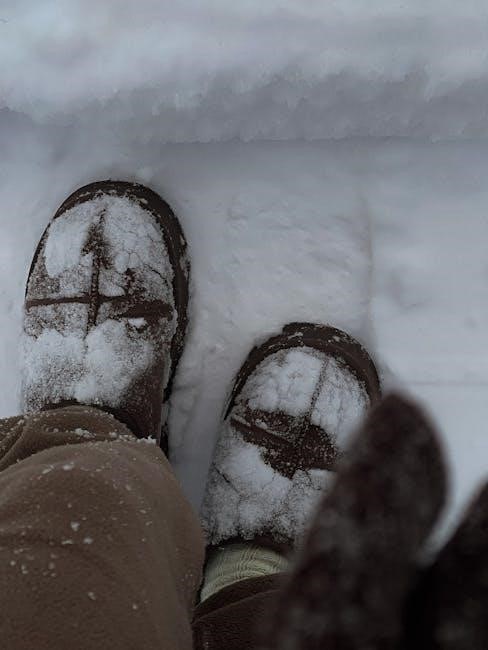This guide provides information on boot insulation to help prepare for cold weather conditions, including snow and freezing temperatures, and offers tips on choosing the right insulation for your needs every day.
Importance of Boot Insulation
Cold feet can be uncomfortable and impact the rest of the body, making boot insulation crucial for outdoor activities in cold weather. Insulation creates a barrier against cold temperatures, reducing the risk of frostbite and circulatory issues. Properly insulated boots can help keep feet warm and dry, improving overall comfort and performance. In extreme cold conditions, insulation is essential to prevent serious health complications. The importance of boot insulation cannot be overstated, as it plays a critical role in maintaining foot health and wellness. By understanding the importance of boot insulation, individuals can make informed decisions when selecting boots for their specific needs and activities. Whether hunting, hiking, or working in cold conditions, boot insulation is a vital component of outdoor gear. It is essential to consider the importance of boot insulation when choosing boots to ensure optimal performance and comfort in cold weather conditions, every time and always.
Different Levels of Boot Insulation
Boot insulation is measured in grams, with various levels available to suit different needs and activities. The most common range is 200g to 600g, with 400 grams being the most widely used. Higher gram ratings, such as 1000g or 2000g, offer more intense insulation for extreme cold conditions. The level of insulation required depends on factors such as the temperature, activity level, and individual tolerance to cold. For example, lighter insulation may be sufficient for mild winter conditions, while heavier insulation is necessary for more extreme cold. Understanding the different levels of boot insulation is essential to selecting the right boots for specific needs and activities. By considering the various levels of insulation, individuals can choose boots that provide the necessary warmth and protection for their feet. This ensures optimal comfort and performance in cold weather conditions, and helps to prevent discomfort and potential health issues.

Common Types of Boot Insulation
There are several common types of boot insulation available including synthetic and natural materials used daily.
Types of Insulation
There are several types of insulation used in boots, including synthetic and natural materials. Synthetic insulation is made from man-made materials, such as polyester or nylon, and is often used in less expensive boots. Natural insulation, on the other hand, is made from materials such as down or wool, and is often used in higher-end boots. Some boots also use a combination of synthetic and natural insulation, which can provide the best of both worlds. The type of insulation used can affect the warmth, weight, and durability of the boot. Insulation can also be treated with water-repellent coatings to help keep feet dry in wet conditions. Overall, the type of insulation used is an important factor to consider when choosing a pair of boots, as it can greatly impact the overall performance and comfort of the boot. Boot insulation is a critical component of a boot’s design.
Thinsulate Insulation
Thinsulate insulation is a type of synthetic insulation that is commonly used in boots. It is made by 3M and is known for its warmth, lightweight, and breathability. Thinsulate insulation is measured in grams, with higher gram weights providing more warmth. For example, a boot with 200g of Thinsulate insulation would be suitable for mild cold weather, while a boot with 1000g of Thinsulate insulation would be better suited for extreme cold. Thinsulate insulation is also moisture-wicking, which helps to keep feet dry and comfortable. It is often used in work boots, hiking boots, and other types of footwear where warmth and durability are important. Thinsulate insulation is a popular choice among boot manufacturers due to its effectiveness and versatility; It can be used in a variety of applications, from casual to extreme outdoor activities. Thinsulate insulation provides excellent warmth and comfort, making it a great option for those who spend time outdoors in cold weather.

Work Boot Insulation Ratings
Work boot insulation ratings are measured in grams, indicating warmth and protection levels for workers in cold environments every day always.
Insulation Ratings
Insulation ratings are a crucial factor in determining the warmth and protection of work boots. The ratings are typically measured in grams, with higher ratings indicating greater warmth and insulation. For example, a boot with a 200g insulation rating would provide less warmth than a boot with a 1000g insulation rating. The insulation ratings are usually categorized into different levels, such as light, medium, and heavy, to help workers choose the right boot for their specific work environment. The insulation ratings also take into account the type of insulation used, such as Thinsulate or similar technology. By understanding the insulation ratings, workers can make informed decisions when selecting work boots that meet their specific needs and provide adequate protection against cold temperatures. This information is essential for workers who spend extended periods outdoors in cold environments, as it helps prevent cold-related injuries and illnesses.
Insulation Weight and Temperature

The relationship between insulation weight and temperature is critical in determining the effectiveness of work boot insulation. Generally, a higher insulation weight corresponds to a lower temperature rating, meaning the boot can withstand colder temperatures. For instance, a boot with 2000g of insulation can handle temperatures below -30 degrees, while a boot with 200g of insulation may only be suitable for temperatures above 30 degrees. The insulation weight and temperature correlation is essential for workers who need to perform tasks in extreme cold environments. By considering the insulation weight and temperature rating, workers can choose the right boot to ensure their feet remain warm and protected. This, in turn, helps prevent cold-related injuries and illnesses, such as frostbite and hypothermia, allowing workers to perform their tasks safely and efficiently in cold environments. The insulation weight and temperature rating are vital factors in selecting the right work boot.

Choosing the Right Boot Insulation
Selecting proper boot insulation is crucial for comfort and safety in various environments and conditions every single day always.
Guidelines for Choosing Insulation
To choose the right insulation, consider the temperature and conditions you will be in, as well as your personal comfort level.
Think about the activities you will be doing and the level of insulation you need to stay warm and comfortable.
Look for insulation that is breathable and moisture-wicking to prevent blisters and discomfort.
Consider the weight and bulk of the insulation, as well as the overall weight of the boot.
Read reviews and talk to others who have used the insulation to get a sense of its performance and durability.
By following these guidelines, you can choose the right insulation for your needs and stay warm and comfortable in cold weather conditions.
Remember to also consider the type of boot and its intended use, as well as your own personal preferences and needs.
This will help you make an informed decision and choose the best insulation for your boot.
Boot Insulation Guide by Rocky Boots
Rocky Boots offers a comprehensive guide to help you choose the right boot insulation for your needs.
The guide provides information on the different types of insulation available, including Thinsulate and other materials.
It also explains the importance of considering factors such as temperature, activity level, and personal comfort when selecting insulation.
Rocky Boots’ guide is designed to help you make an informed decision and choose the best insulation for your boot.
The guide is based on the company’s expertise and experience in manufacturing high-quality boots with effective insulation.
By following the guide, you can ensure that your boots will keep your feet warm and comfortable in cold weather conditions.
Rocky Boots’ guide is a valuable resource for anyone looking for reliable and trustworthy information on boot insulation.
The guide is easy to understand and provides practical advice and recommendations for choosing the right insulation for your needs.
